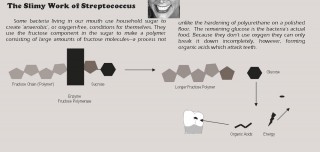The Truth About Juice
Is fruit juice really so bad for you? Harald Breiding-Buss explains the science behind sugar-induced tooth decay.
Once hailed as an easy and important source of vitamins, fruit juice has definitely fallen from grace with health professionals, and is now seen as a significant contributor to tooth decay.
You, too, may have seen those educational displays showing little bags of sugar next to pictures of fizzy drink and fruit juice.
The message: fruit juice contains almost as much sugar as cola.
Parents seem somewhat hesitant to cut fruit juice out of their children’s diet altogether, however. It is a natural product after all, so can it really be so bad?
Probably not as bad as it’s made out to be. True, there is a lot of sugar in fruit juice – but not all sugars are created equal:
The culprits of tooth decay are bacteria, mostly Streptococci that live in your mouth and that feed on sucrose (aka dextrose), which is the commercially produced form of sugar that you buy in bags and that is added to food and soft drinks.
Chemically, sucrose is a ‘bi-sugar’ consisting of the two sugars fructose and glucose chemically bonded together.
The peculiar thing about Streptococcus is that they do not tolerate oxygen, meaning they have to find ways to stay out of the air.
But no matter how bad your breath is there is still plenty of oxygen in your mouth at all times, so Streptococcus produces a slimy coating that keeps it sheltered from it, and that contributes to what is known as plaque.
In order to produce this coating Streptococcus possesses an enzyme (a protein that facilitates a chemical reaction) that chains together the fructose parts of sucrose forming what is called a ‘polymer’ slime, which keeps the bacteria cells nicely out of the way of air. In order for the chain to grow, the enzyme needs to tie sucrose to an existing fructose chain, leaving glucose left over.
In air-breathing organisms glucose is completely broken down to water and carbon dioxide. But since Streptococcus does not like air, it does not break it down completely and instead forms organic acids out of it.
 These acids are what attack your teeth (see shaded box).
These acids are what attack your teeth (see shaded box).
Conveniently for Streptococcus, the action of the acid forms niches and holes which allows it to withdraw even further from where the air is. Just as important, attacking your teeth neutralises the acid. Streptococcus, like the rest of us, it cannot survive in a pool of acid.
Plants naturally form sucrose, but it is not usually the dominant type of sugar in fruit. It is mainly a way to store sugar for plants and it’s relatively more common in other plant parts such as roots or stems. Sugar cane or sugar beet are examples.
In fruit the predominant forms of sugar are glucose and fructose, but not the chemically bonded version of sucrose. Neither glucose nor fructose has the same detrimental effect on your teeth, and neither do the two sugars mixed together.
Only if they are present in the form of sucrose can the enzyme of streptococcus do its slimy work. This explains why even in regions where fruit has been a large part of humans’ diet in pre-industrial times, our ancestors did not have these kind of tooth problems.
Fruit has been so much part of humans’ diet throughout our history, in fact, that humans are amongst only very few species of mammal that have done away completely with making our own vitamin C.
So does fruit juice damage our teeth?
Provided it has no added sugar (and depending on how concentrated it is) the sucrose content of fruit juice is much, much lower than that of all other non-diet sweet drinks, but it is not insignificant. Ironically, some types of vegetable juice contain more of the ‘bad’ sugar.
As with other sugar-containing foods and drinks the amount of sugar in it is less important than the length of exposure to it. Fruit juice supplied in a baby bottle or cup for a toddler to continuously suck on creates a constant supply of sucrose for the bacteria on their teeth.
But when drinking a glass of juice, especially with food, the risk to your teeth is pretty low and the vitamins contained in it are very good for you.
Even if it is not sucrose, sugar will still give you an instant energy boost, which is not necessarily what you want to achieve in your child. Glucose, generally the most prevalent type of sugar in fruit, is the most readily available form of energy for any organism.
Your muscles, or any other cells of your body, can burn it with instant energy gain. It is especially sweet to our taste, because our body loves it – no need to expend energy first to re-build it into something suitable for burning. It is a key part of every organism’s metabolism.
Fructose, contained especially plentiful for example in pears, does not break down quite so easily and, within limits, can even be used as a sugar substitute by diabetics. Sucrose needs to be split into glucose and fructose first before the body can use it as energy, but still’ works’ pretty quickly. The fructose part in it ensures that the ’sugar high’ lasts a bit longer.
There is a lesser known side-effect of sucrose consumption, however, which for some people may be more of a problem than the effect on your teeth. The enzyme responsible for this first step in metabolising sucrose requires Vitamin B12 – a vitamin that is also crucially important for the health of your skin. So if your teenager is worried about his acne, cutting out sugar for a few days can bring pretty quick improvements as well as calm them down somewhat.
Bon appetit
Next: The Beauty Myth





